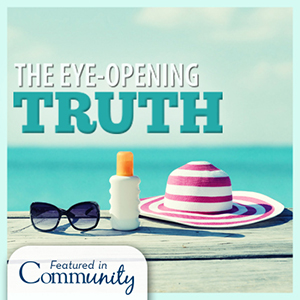The Eye-Opening Truth
- Category: Community Newsletter
- Posted On:

As outdoor activity soars during sunny summer weather, so do your chances of sun damage.
From causing cancer to cataracts, the sun’s harmful Ultraviolet (UV) rays are dangerous to the body, and health care professionals suggest taking precautions to protect your skin—and eyes—from their effects.
“Exposure to UV rays reaches the peak during summer days from 10 a.m. to 2 p.m. so it’s best to avoid the sun during those times,” cautions Ophthalmologist Dr. Daniel Dodson of North Oaks Eye Care Clinic. ”If you don’t, you increase the risk of cataracts, age-related macular degeneration and growths on the eyes, including cancer.”
Dr. Dodson advises his patients to wear sunglasses and broad-brimmed hats to protect their eyes. Never look directly into the sun, even on a cloudy day, he warns. “I see skin cancer on the eyelids frequently,” he notes. “People just don’t think about their eyelids getting sunburned, but it happens.”
Eyelid skin cancer accounts for about 5 to 10 percent of all skin cancers. When diagnosed and treated early, eyelid cancer usually responds well to surgery and follow-up care.
An avid swimmer and gardener, Helene Russell of Ponchatoula noticed a small bump on her eyelid and neglected seeking a medical opinion, thinking it was just a result of aging. At the insistence of her husband, the 56-year-old had the bump examined. It was identified as basal cell carcinoma, one of the most common forms of skin cancer. Although she never steps outside without sun glasses, the cancer may have developed from exposure to UV rays as a child.
“Most skin cancers are a direct result of exposure to the UV rays in sunlight, and can even be linked to some artificial sources of UV,” Dermatologist Dr. Rebecca Soine of North Oaks Dermatology Associates explains. “Studies have found that people who use tanning beds or booths have a higher risk of cancer.”
Linda Bridges, 57, of Kentwood is a self-proclaimed “sun worshipper” who began regular sun tanning when she was a teenager. About 20 years ago, she added tanning beds to her routine. During a recent check-up, Dr. Soine removed 55 suspicious skin samples from Linda, and performed three biopsies. Two came back positive for cancer.
“I wish I had known years ago what I know now and paid more attention. When the tanning beds came along, I thought they would be better for my skin, but it turns out they have added to the damage,” Bridges notes. “Now, I wear sunscreen and long sleeves all the time.”
Skin cancer is almost an epidemic among patients 25 to 40 years old, according to Dr. Soine. Like Dr. Dodson, she urges patients of all ages to avoid peak sunlight, apply sunscreen, cover exposed skin and check regularly for suspicious skin spots.
For more information on how to protect yourself from the sun, speak with your health care provider or call North Oaks Eye Care Clinic at (985) 230-3937 or North Oaks Dermatology Associates at (985) 542-4988.
Updated July 2017




[1].jpg)